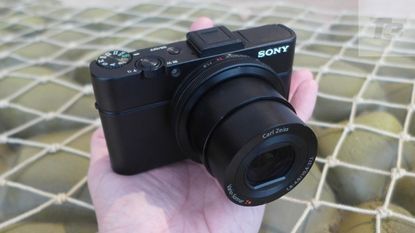Is this premium compact the best for build and image quality and is it worth the price? Find out in our Sony Cyber-shot RX100 II review
There are very few, if any, non-interchangeable lens pocket cameras that can in the right hands ape the effects of a digital SLR near enough to fool all but the most trained pair of eyes. But the premium-feel aluminium build Sony Cyber-shot RX100 II comes pretty close.
Part of this is to do with the larger than average 1-inch CMOS sensor at its heart - a bigger physical size than the 1/2.3in chip at the centre of most pocket compacts - complete, in the Sony's case, with a 20.2 effective megapixel resolution. Again this is large for a camera of its pocket-friendly dimensions.
The other reason why its images cut the mustard is down to the Carl Zeiss lens at the front offering a bright/fast f/1.8 aperture. This allows not only for a better low-light performance, but also for those shallow depth of field shots with attractively blurred backgrounds that we're more commonly used to seeing produced by a decent DSLR or compact system camera.
The RX100 II is neither, as the lens here is resolutely fixed. So it's a good job that it's a good 'un, with the 3.7x optical zoom offering a 35mm equivalent focal range of 28-100mm. Image quality tends to suffer with longer zooms on pocket cameras, but anyone feeling this is slightly underpowered for their needs is directed to the 7.1x optical Panasonic LF1, or the 10.7x optical zoom Olympus Stylus 1.
The RX00 II also arrives at the party as Sony's first compact camera to include both the latest must-have wireless connectivity options - Wi-Fi and NFC - therefore adding a degree of future proofing and smartphone interactivity.
While the above is all very positive, there is an elephant in the room and that's the RX100 mark II's price: a wince-inducing £649. Yes, that is a lot of money to pay for a compact camera.
The spend is comparable to a mid-range DSLR or compact system camera on which you have the advantage of not only being able to swap the lens in use, but an even larger APS-C sized sensor than the RX100 II supplies.
But not everyone wants to cart around a bagful of lenses everyday, so there is a time and a place for the RX100 II for those looking for the best quality achievable from the smallest possible package.
It makes an ideal travel camera or alternatively a high-quality second camera for someone who already owns a DSLR, but wants their photographs turning out more professional looking than the snaps otherwise generated by lower priced 1/2.3in sensor incorporating snapshots.
Sony Cyber-shot RX100 II: Controls
Apart from a thumb-operated mode wheel and a sunken shutter release button ergonomically encircled by an electronic zoom lever, the RX100 II's buttons are almost pinhead small.
And yet, like a handful of rival pocket compacts that are all slightly better than they have any right to be - including the Canon PowerShot S120, Fujifilm XQ1 and Panasonic Lumix DMC-LF1 - the RX100 II here provides a manually operated ring encircling the lens.
We liked the fact that this gave us the feeling of hands-on control while also offering a short cut to adjusting camera settings into the bargain.
The degree of customisation is such that we can use the control ring to tweak the likes of exposure and picture effects. Naturally it can also be used for manually zooming, with a stepped focal range displayed top of screen via a cool-looking virtual dial.
Creative functions including aperture can be adjusted for Full HD video as well as stills, so that anyone wanting to keep subjects sharp while blurring the background can.
A tiny dedicated video record button is wedged into the top right-hand edge of the backplate, out of harm's way, but implemented in such a fashion that actually makes it fiddly to use.
Still, when you want both a pocket-size camera and a degree of control into the bargain, there are compromises to be made. Happily, we don't feel any of the RX100 II's are deal breakers.
Sony Cyber-shot RX100 II: Screen
A tilting rear plate LCD is a real bonus on a camera this small; however it isn't a touch screen, which may have provided a 'best of both worlds' approach.
Still, in lieu of a built-in eye-level viewfinder, being able to adjust the angle of the rear panel monitor is a real boon for lining up creative shots. And Sony provides a razor-sharp 1.28-million dots of resolution too, just so we don't feel short changed.
Though there is no eye level viewfinder included on the RX100 II, if you really want to splash the cash an electronic variety can be bought separately in the FDA-EV1MK EVF, which retails for a steep £380.
The camera's hot shoe allows us to pimp it with such an EVF, thereby providing access to DSLR-like image framing, with camera settings placed within our eye line.
Sony Cyber-shot RX100 II: Battery
The Sony's rechargeable lithium-ion battery provides a fairly standard 250 shots from a full charge. This compares fairly with other premium compacts including the Fujifilm XQ1, Olympus Stylus 1 and Panasonic Lumix DMC-LF1; all of which also manage to eek out between 240-250 snaps.
The only better performance in its class is via the Canon PowerShot S120, which has a battery life lasting 300 shots.
Sony Cyber-shot RX100 II: Picture quality
A larger sensor than normally found in compact cameras of this size means better image quality than its dimensions may suggest. A big sensor and high resolution is all very well though, but you also need a decent lens to direct the light - and the bright and fast Carl Zeiss lens here fits the bill.
Those persevering with the Sony's small and fiddly rear plate buttons will be rewarded with stunning imagery and video that comes with the benefit of stereo sound. The lens allows us to get as close as 5cm for still life shots, running to infinity at the telephoto end of the zoom.
In short, it's a more creatively flexible camera than its initially modest seeming focal range might suggest to the uninitiated.
Sony Cyber-shot RX100 II: Verdict
The 20.2 effective megapixel 1in sensor incorporating Sony Cyber-shot RX100 II is the advanced compact we'd most like to own if budget wasn't a prime concern. Alternatively we'd go for the £350 Fuji XQ1 if it was, or seek out an older first-generation Sony Cyber-shot RX100 - currently £250 cheaper than the mark II version, but which misses out on several key features like a tilting LCD.
This latest model is a heavyweight contender for features and construction that is perhaps more aimed at the photo hobbyist than casual shooter. If you classify yourself as the former then you'll probably already own a very good DSLR - so spending £600+ on a pocket compact as a second camera seems more like a practical possibility than a foolhardy venture.
What you can't argue with is the RX100 II's quality, which puts it in a class of its own.
Sony Cyber-shot RX100 II release date: Out now
Sony Cyber-shot RX100 II price: £650





